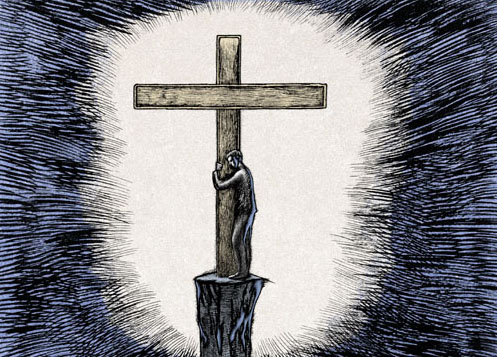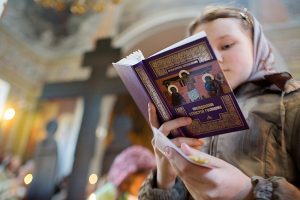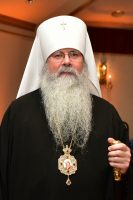In the name of the Father, of the Son, and of the Holy Spirit.
Last week, when we celebrated the memory of St. Gregory Palamas, I tried to speak about how belief is inextricably bound to the experience of the triune and tri-personal God. Life on this side of the grave is called to participate in the Divine life and that indeed fundamental to our faith is the reality of God becoming a human being so that the human being might become God. To take this a step further, we have the cross in our midst today and we have just heard the Gospel according to St. Mark.
What does our Lord mean when he says, “If you want to follow me, you must deny yourself – you must disown yourself – and take up your cross and follow me?” Applying these words is the basis for a living faith and therefore the basis for an authentic experience and life with the living God.
Just as belief is bound to the experience of God, we are compelled by the Lord himself to know what the “word” of the cross is. We are obliged to know what denying or disowning the self demands of a disciple of Jesus Christ. For unless we apprehend the “word” of the cross, the living, saving, transfiguring and deifying experience of God remains as an idea which ultimately has no real impact on our lives. By not knowing or living the “word” of the cross our minds and hearts are joined only to an idea of Christ formed by our own thoughts and feelings which have little or nothing to do with the challenge of the cross.
To deny ourselves is an act by which we entrust ourselves to the care and love of God. But trust demands that we make ourselves “vulnerable.” To accept the cross is to stand in a place in which we are exposed to the possibility of being harmed. This is exactly what the Latin root of “vulnerable” means – “able to be wounded.” Our Great High Priest, the pre-eternal Word and Son of God makes himself vulnerable. He empties himself (kenosis). He submits to arrest, trial, crucifixion, death and burial. The Lord makes himself vulnerable. He exposes himself to be wounded.
If we are to take the “word” of the cross seriously, if we are not to succumb to the thought that the cross is a scandal or that it is foolishness, then we are to apply this “word” to ourselves and make ourselves vulnerable. The cross calls us to disown the self.
We know how difficult and fearful this is. We know that it is easier to simply confess or profess the “word” of the cross and not to apply it to our life. Here we need to ask ourselves if our acceptance of the cross goes beyond a verbal profession and places us in that vulnerable place where we encounter the divine and uncreated light. Does the “word” of the cross impact the mind and the heart, the will and energy of our being? Or is our profession reduced to an intellectual exercise fostered by a curiosity in the Bible, the fathers and the aesthetics of liturgical worship? Indeed, to enter into the reality of this liturgy – to attend to the Scripture and to acquire the self-emptying spirit of the fathers – we are called to become vulnerable. We are called to break down every wall that surrounds us, that insulates us, that isolates us from entering into communion with God, our neighbor and oneself.
As we think about this let us also think how the cross provides the word for the Church’s life in and for the world. We live in a time when we hear many things about Christian social doctrine. There are bishops, priests, and laity in the Orthodox Church who, with sincere conviction, speak about the Church’s responsibility to be involved in our culture. They issue the call for the Church to become the conscience of the culture by engaging in the culture wars of our day. From one perspective we can see how this is a noble call. However, for the call to remain noble it must be based on the “word” of the cross.
Before examining this call, let us first look at three extreme ways the Church has adopted to manifest itself to the world. The first is isolationism or sectarianism. Many Orthodox Christians hold to the perverted or distorted view of the Church as ghetto. As we know, the Church does not necessarily have to be a homogeneous ethnic ghetto. It can be a bona fide “American” or heterogeneous ghetto surrounded by the walls constructed by doctrine, patristic writings and, of course, the Bible. These walls isolate the Church from the world. These walls protect the Church from becoming vulnerable. Within its safe enclave, the Church can only condemn the world being unable to glean from the world what is good, true and beautiful. It confines itself to a place that is “safe” in as much as it doesn’t expose itself to the trials, challenges and sufferings of the world and, consequently, to the trials, challenges and sufferings of every human being.
The second extreme reveals the Church as an institution which opens itself to the world to the extent that it capitulates to the ways of the world, rendering it unable to manifest the kingdom which is to come. Given this extreme, the tension between the kingdom of God and the kingdom of this world ceases. Capitulating to the world, the Church removes itself from becoming vulnerable.
The sectarian extreme makes an idol of the Church’s living tradition. Its only point of reference is the past. The “worldly” or “relevant” extreme supports an iconoclasm that sees the living tradition of the past as something to be ignored due to the scientific, technological and philosophical “advances” of the ever-changing present. Both of these extremes ultimately deny the ongoing presence and work of the Holy Spirit.
This brings us to the third extreme, which is gaining momentum within our small Orthodox Church in America. As was already mentioned, bishops, priests and laity are drawn to the idea that the Church is called to reveal its life and vision to American culture. Yes, our history tells us that the Church has played a major role in the moral, cultural and intellectual formation of various nations and cultures. On the other hand we also know that the marriage between Church and State has compromised the Gospel and rendered the cross a weapon of suppression and destruction. The formation of Christian cultures were not infrequently the result of the Church “imposing” its life, from a position of power and security, due to its marriage with the empire or state. Our history teaches us that the abused spouse in this marriage is always the Church which gradually compromised the cross by transforming it into a weapon of tyranny, division and destruction.
This third extreme seeks to establish a “symphony” between the Church and certain politicians and or political parties that ostensibly appear to be in harmony with its own ethos. This alliance with politics also reduces the tension between the Church and the world. Seeking to give the Church visibility and even a modicum of respectability, this third extreme seeks to change the conscience of American culture by becoming a political force that will eventually enable it to wield its influence to legislate morality. This third extreme removes the Church from its vulnerable place within our culture for it strives to unite itself with the rich and powerful from which it derives its political and social influence. It tempts the Church to join with forces that seek to “impose” a social doctrine that ultimately causes the Church to forget that its work is to change the minds and hearts of the people. There can be no imposed or legislated metanoia.
Finally, there is the via crucis – the way of the cross – the way of vulnerability. Like the Lord himself, the Church works in and for the life of the world by emptying itself of all worldly power and glory. This seems to be the great opportunity being offered the Church in its American sojourn. America offers the Church the possibility to make its presence known through its very “weakness” derived from the cross. For in its weakness the Church reveals its supreme power and authority. As the Lord ascended the cross in his extreme humility his theanthropic being was not compromised. On the contrary, the divine/human power of the Savior is revealed to the world through his voluntary vulnerability. Likewise, the Church by assuming its vulnerable place in our culture will simultaneously reveal its strength, glory and freedom. How all this is going to unfold remains to be seen. However, we can be assured that by being vulnerable, the Church will be able to properly dialog with the world – with the other.
In the past, I have shared the following quote with all of you. I share it again because it is apropos to what we are celebrating today. The quote is an excerpt from an interview given by Metropolitan Anthony Bloom in 1990. Metropolitan Anthony died in 2003, so at the time of the interview he was at the prime of his thinking, a seasoned pastor and hierarch who desired to utilize the Church’s theology to serve and save the world. The excerpt was quoted in an article that appeared in Le Messager in 2009. This is what Metropolitan Anthony boldly affirms: “It seems to me, and I am personally convinced, that the Church must never speak from a position of strength. [These are shocking words.] It ought not to be one of the forces influencing this or that state. The Church ought to be, if you will, just as powerless as God himself, which does not coerce but which calls and unveils the beauty and the truth of things without imposing them.”
“Without imposing them.” There is an attitude developing in the Orthodox Church – throughout the world and not just in America – which wants the Church to act from a position of worldly or political power so as to impose it’s ethos on everyone.
Metropolitan Anthony continues, “As soon as the Church begins to exercise power, it loses its most profound characteristic which is divine love [i.e.] the understanding of those it is called to save and not to smash…”
The Church is given for the life of the world and its salvation. The cross which we venerate, which we wear, which we hold up, which we proclaim as the invincible trophy and weapon of peace is bound t the humility of the God-Man . And, I would say that, these words of Metropolitan Anthony brilliantly capture and articulate what the “word” of the cross is. The “word” exhorts us personally and corporately, as the Church, to be a presence in the world, not a powerful presence, but to be the humble presence which is able to reveal the beauty, light and glory of God. In its humility, the Church is truly free and therefore able to dialog with anyone whose mind and heart is open to knowing the Truth. Yet, as I have said to some of you, dialog is one of the most vulnerable acts that the Church can submit to. Why? Why is dialog risky? It is risky because it opens us to the possibility that we are wrong. Dialog draws us, personally and corporately as the Church into a very vulnerable place. For, even though we have the Scriptures, the Fathers and this Liturgy we must never forget that these sources are not exhaustible when it comes to proclaiming the Truth who is Jesus Christ. So often we Orthodox Christians overlook the fact that these sources, which are so precious to us, which express the living Tradition of the Church nurtured by the Holy Spirit, open to us the reality of Truth who is inexhaustible. The Truth who is Jesus Christ is not exhausted by the word of Scripture. His divine/human economy is not exhausted by the word of the Fathers. The mystery of the Lord’s cross and therefore the love and compassion of the triune and tri-personal God for humanity and all creation is not exhausted by the celebration of this Liturgy.
The Lord is inexhaustible, and when we enter into dialog we might discover that the person we are facing has penetrated into the Truth and has grasped an aspect of the Truth which we need to apprehend. When dialoging we may very well have to concede to the fact that the person (persons) we are dialoging with has been touched by the Holy Spirit. Encountering the Truth in the other enables us to make that Truth our own.
Encountering the Truth in the other allows us to approach the other and to embrace the other. In this embrace we find ourselves in a vulnerable position that opens us to be wounded and changed by a new and holy encounter with the Truth.
To stand in this dialogical embrace is very difficult. Nevertheless, if we don’t take this risk then, dear brothers and sisters, beginning with myself, all that we do here in the context of this Liturgy – including holding and venerating the cross – is to my condemnation, to my death which begins now on this side of the grave.
The cross is in our midst. It beckons us to be a people who are not afraid to stand beautifully, and therefore to stand humbly. It beckons us to be open the working of the Spirit who is everywhere present filling all things. The cross is in our midst. We are called to embrace it. We are called to venerate it. We are called to offer it to the world so that the world might see that the One upon this cross is the one who renews everyone and everything now and forever. Amen.
Source: Holy Trinity Orthodox Cathedral

















